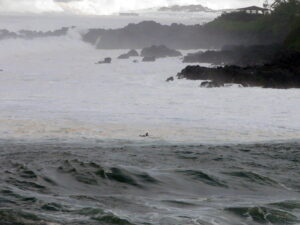
Winter’s strong current, cloudy water and cold temperatures are not ideal snorkeling conditions. January at Waimea Bay. ©Susan Scott
February 4, 2023
One day in the early 1980s, I rushed from a class at UH Manoa to meet my partner at Kailua Beach Park.
“The beach?” my Hawaiʻi-raised lab partner said. “It’s winter.”
Those were my early years of living on Oahu, and having arrived from snowy Denver, I laughed about Hawaiʻi residents talking about cold winters. Now I’m one of them. Wind, surf, and rain runoff have been keeping me from snorkeling, and my beach walks are often races against black clouds.
But even when winter weather keeps me from the ocean I love, I welcome the season, because with it comes the migratory shorebirds I also love. They survive and thrive because of Hawaiʻi winters. The birds nest and raise chicks in the buggy Arctic summers, and ahead of the North’s frozen, foodless winters, the birds fly south.
Lucky for us, several populations of those shorebirds spend their winters in Hawaiʻi. Four species are fairly common here. Of those, the wandering tattler, is probably the least well-known.
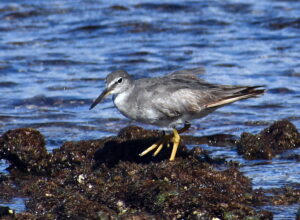
A Wandering Tattler or ‘Ūlili. ©Susan Scott
Years ago, during a visit to the Galapagos Islands, our guide pointed to a gray bird on the beach and said to Craig and me, “Look, you Hawaiʻi residents—there’s a Wandering Tattler, one of your birds.”
We smiled and nodded. Neither of us had even heard of a Wandering Tattler.
I’m more bird conscious now, and although I’ve come to recognize Wandering Tattlers, I don’t see them often or know much about them. When I looked up Wandering Tattler for this article, I found in my best source, Birds of the World, Cornell Lab of Ornithology, this statement: “To this day the Wandering Tattler remains one of North America’s least known birds.” OK, then.
Ancient Hawaiians knew this shorebird, naming it after its distinct call: ‘Ūlili. Say it, oo-li-li, and the sound may conjure up the image of a gray bird with yellow legs pecking alone along our rocky shores.
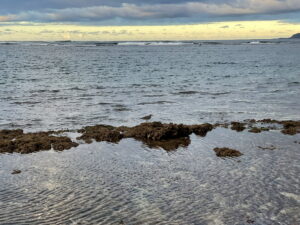
Wandering Tattlers prefer to forage alone. Waialua Beach, Oahu. ©Susan Scott
When it comes to being noticed, most of us beach walkers recognize Sanderlings, the gray-and-white sandpipers (sandpipers being a large family of shorebirds) that scurry up and down our beaches like little wind-up toys.
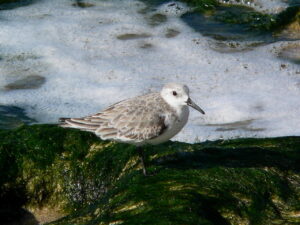
The Sanderling, called Hunakai in Hawaiian, is a member of the sandpiper family. ©Susan Scott
Of the world’s shorebird species, sanderlings are the most widespread. During the Northern Hemisphere’s winters, Sanderlings can be found on any sandy beach on the planet, flying as far south as the tip of South America.
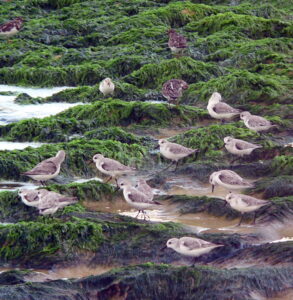
Hunakai sometimes forage in flocks with other shorebirds, such as the three Ruddy Turnstones at top. Laniakea, Oahu. ©Susan Scott
Here in Hawaiʻi, we see these 8-inch-long birds outrunning breaking waves, and then following the receding water in search of shrimp, crabs, and snails. The Hawaiians aptly named the bird Hunakai, meaning sea foam.
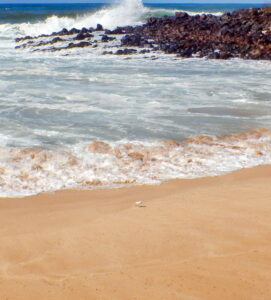
A lone Sanderling races the waves at Pāpōhaku Beach on Molokai’s west end. ©Susan Scott
The third common shorebird visitor here is the Ruddy Turnstone, a species that often forages in flocks. The well-named ruddies flip stones with a stout upper beak to find and eat insects and crustaceans. But these resourceful birds do more than turn stones. In places where live food is scarce, ruddies will eat anything they find, including dead animal flesh, human garbage, and unattended eggs of other birds.
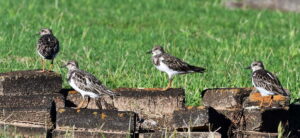
Ruddy Turnstones in winter colors, Puuiki Cemetery. Waialua, Oahu. ©Susan Scott
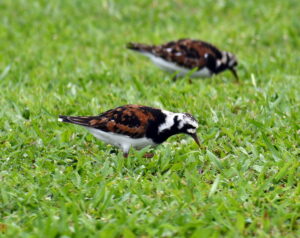
Ruddy Turnstones in April breeding colors. In spring, all our shorebirds grow bright-colored feathers in preparation for spring mating. Haiku, Oahu. ©Susan Scott
Years ago, while working on Tern Island in Hawaiʻi’s Northwest Chain (now the Papahanaumokuakea Marine National Monument), I watched four Ruddy Turnstones pull tapeworms from the anus of a sleeping monk seal, and then fight over the prize, tearing the long worm to pieces as they raced down the beach. Another time, I saw a turnstone peck a scab off a monk seal’s back wound, and sip the oozing blood. Now that’s survival.
The last of the four shorebirds that winter in Hawaiʻi is our most common, and much-loved, Kōlea, also called the Pacific Golden-Plover. We know this bird well because the individuals that winter in Hawaiʻi have learned to live with us.
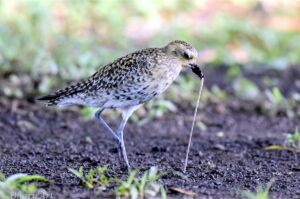
Earthworms are not native to Hawaiʻi. The first were recorded in 1896 and have since spread successfully throughout the Islands. This photo of a Kōlea catching an earthworm on Oahu was shared with me by © Harumi Fujimoto.
Kōlea love the short grass we maintain on our golf courses, parks, and yards because they’re crawling with the countless insects, bugs, and worms we’ve introduced to Hawaiʻi. Neither the birds’ modern-day habitats nor the food they eat are native to the Islands, yet the Kōlea thrive. Such adaptation is another reason to admire these remarkable birds.
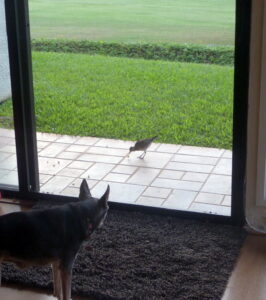
This Kōlea we named Gloria learned that when the screen door was closed, it was safe to come to the lanai for the scrambled egg I offered her each morning. ©Susan Scott
To read the latest news about our precious plovers go to Kolea Count. The NEWS tab there has the latest study we did with our Kōlea, called “Fly 6,000 miles with talking backpacks? No Problem.”
Yes, we’ve had some calm sunny days that would have been good for snorkeling, but, well, it’s chilly. I’ll get back to swimming one of these days, but right now, I’m walking the parks and thanking the shorebirds I see for choosing to spend their winters in Hawaiʻi.